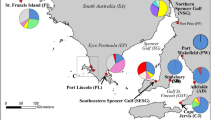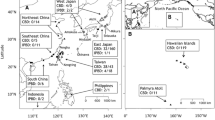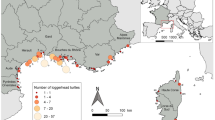Abstract
Shark nets placed along the coast of KwaZulu-Natal to protect bathers from shark attacks result in an incidental by-catch of bottlenose dolphins (Tursiops aduncus) at twice the level suggested by the IWC as the maximum sustainable capture rate for a cetacean population. Observational data reported the presence of at least two putative populations, one a seasonal migratory population moving into the KwaZulu-Natal area following the movement of sardines, and the other a coastal, apparently resident population. Some observations indicated possible further subdivision of the coastal population. We analysed nine microsatellite loci and 599 bps of the mitochondrial control region and found small but significant differentiation within the putative coastal population (FST = 0.022) separated north and south of Ifafa. There was weaker evidence for differentiation between the southern coastal and migratory populations (FST = 0.012). Genetic diversity was low for both types of markers in all populations, and the pattern of mtDNA variation was consistent with a founder event. Considering the high capture rate, the low level of genetic diversity, and the evidence of possible population differentiation along the coast, we suggest that particular care should be taken in managing the take from shark nets especially in the north coastal area of KZN where the population showed the higher degree of differentiation.



Similar content being viewed by others
References
Anon (1991) Report of the workshop on mortality of cetaceans in passive fishing nets and traps. La Jolla, October 1990. Cambridge; International Whaling Commission, 94 pp
Bandelt HJ, Foster P, Röhl A (1999) Median joining networks for inferring intraspecific phylogenies. Mol Biol Evol 16:37–48
Barrett-Lennard LG, Smith TG, Ellis GM (1996) A cetacean biopsy system using lightweight pneumatic darts, and its effect on the behavior of killer whales. Mar Mamm Sci 12:14–27
Bérubé M, Palsboll P (1996) Identification of sex in cetaceans by multiplexing with three ZVX and ZFY specific primers. Mol Ecol 5:283–287
Bowcock AM, Ruíz-Linares A, Tomfohrde J, Minch E, Kidd JR, Cavalli-Sforza LL (1994) High resolution human evolutionary trees with polymorphic microsatellites. Nature 368:455–457
Cavalli-Sforza LL, Bodmer WF (1971) The genetics of human population. W.H. Freeman and Company, San Francisco, p. 399
Cliff AD, Ord JK (1973) Spatial autocorrelation. Pion Limited, London
Crockcroft VG, De Kock AC, Lord DA, Ross GJB (1989) Organochlorines in bottlenose dolphins Tursiops truncatus from the eastern coast of Southern Africa. S Afr J Mar Sci 8:207–217
Crockcroft VG (1990) Dolphins catches in the Natal shark nets, 1980 to 1988. S Afr J Wildl Res 20:44–51
Cockcroft VG, Ross GJB, Peddemors VM (1990). Bottlenose dolphin Tursiops truncatus distribution in Natal’s coastal waters. S Afr J Mar Sci 9:1–10
Cockcroft VG, Ross GJB, Peddemors VM (1991) Distribution and status of bottlenose dolphin Tursiops truncatus on the south coast of Natal, South Africa. S Afr J Mar Sci 11:203–209
Cockcroft VG, Peddemors VM, Borchers DL (1992) Estimates of abundance and undercounting of bottlenose dolphins off northern Natal, South Africa. S Afr J Wildl Res 22:102–109
Cornuet JM, Piry S, Luikart G, Estoup A, Solignac M (1999) New methods employing multilocus genotypes to select or exclude populations as origins of individuals. Genetics 153:1989–2000
Degen B, Petit R, Kremer A (2001) SGS – spatial genetic software: a computer program for analysis of spatial genetic and phenotypic structures of individuals and populations. J Hered 92:447–448
Dieringer D, Schlötterer C (2002) Microsatellite analyzer (MSA) – a platform independent analysis tool for large microsatellite data sets. Mol Ecol Notes 3:167–169
Favre L, Balloux F, Goudet J, Perrin N (1997) Female-biased dispersal in the monogamous mammal Crocidura russula: evidence from field data and microsatellite patterns. Proc R Soc Lond B 264:127–132
Goodwin JA, Durham BD, Peddemors VM, Cockcroft VG (1996) Genetic variation in the bottlenose dolphin Tursiops truncatus along the KwaZulu-Natal coast, South Africa. S Afr J Mar Sci 17:225–232
Goudet J (2001) FSTAT, a program to estimate and test gene diversities and fixation indices (version 2.9.3). Available from: http://www.unil.ch/izea/softwares/fstat.html. Updated from Goudet (1995)
Green DM (2005) Designatable units for status assessment of endangered species. Cons Biol 1813–1820
Hoelzel AR (1998) Molecular analysis of populations; a practical approach. Oxford, Oxford University Press
Hoelzel AR, Dahleim M, Stern SJ (1998) Low genetic variation among killer whales (Orcinus orca) in the Eastern North Pacific and genetic differentiation between foraging specialists. J Hered 89:121–128
Hoelzel AR, Natoli A, Dahlheim ME, Olavarria C, Baird RW, Black NA (2002) Low worldwide genetic diversity in the killer whale (Orcinus orca): implications for demographic history. Proc R Soc Lond B 269:1467–1473
Latch EK, Dharmarajan G, Glaubitz GJ, Rhodes OE Jr (2006) Relative performance of Bayesian clustering software for inferring population substructure and individual assignment at low levels of population differentiation. Conserv Genet 7:295–302
Miller MP (2005) Alleles in space (AIS): computer software for the joint analysis of inter-individual spatial and genetic information. J Hered 96:722–724
Moritz C (1994) Defining “evolutionary significant units” for conservation. Trend Ecol Evol 9:373–375
Natoli A, Peddemors VM, Hoelzel AR (2004) Population structure and speciation in the genus Tursiops based on microsatellite and mitochondrial DNA analyses. J Evol Biol 17:363–375
Natoli A, Birkun A, Aguilar A, Lopez A, Hoelzel AR (2005) Habitat structure and the dispersal of male and female bottlenose dolphins (Tursiops truncatus). Proc R Soc Lond Ser B: Biol Sci 272:1217–1226
Peddemors VM (1999) Delphinids of southern Africa: a review of their distribution, status and life history. J Cetacean Res Manage 1:157–165
Peddemors VM, Best PB, Cockcroft VG, Oosthuisen H (2002) Report on the recent categorization of South African cetaceans according to the 2001 IUCN red list criteria (Ver. 3.1). Unpublished paper SC/54/O22 presented to the IWC Scientific Committee, Shimonoseki, Japan
Pritchard JK, Stephen M, Donnelly P (2000) Inference of population structure using multilocus genotype data. Genetics 155:945–959
Ripley BD (1981) Spatial statistics. Wiley Series in Probability and Mathematical Statistics, New York
Rooney AP, Merritt DB, Derr JN (1999) Microsatellite diversity in captive bottlenose dolphins (Tursiops truncatus). J Hered 90:228–231
Segura I, Rocha-Olivares A, Flores-Ramirez S, Rojas-Bracho L (2006) Conservation implications of the genetic and ecological distinction of Tursiops truncatus ecotypes in the Gulf of California. Biol Conserv 133:336–346
Sellas AB, Wells RS, Rosel PE (2005) Mitochondrial and nuclear DNA analyses reveal fine scale geographic structure in bottlenose dolphins (Tursiops truncatus) in the Gulf of Mexico. Conserv Genet 6:715–728
Schneider S, Roessli D, Excoffier L (1999) Estimation of past demographic parameters from the distribution of pairwise differences when the mutation rates vary among sites: application to human mitochondrial DNA. Genetics 152:1079–1089
Shinohara M, Domingo-Roura X, Takenaka O (1997) Microsatellite in the bottlenose dolphin Tursiops truncatus. Mol Ecol 6:695–696
Sokal RR, Oden NL (1978) Spatial autocorrelation in biology. 1 Methodology. Biol J Linn Soc 10:199–228
Valsecchi E, Amos B (1996) Microsatellite markers for the study of cetacean populations. Mol Ecol 5:151–156
Van Oosterhout C, Hutchinson DP, Wills M, Shipley P (2004) MICRO-CHECKER: software for identifying and correcting genotyping errors in microsatellite data. Mol Ecol Notes 4:535–538
Wang JY, Chou LS, White BN (1999) Mitochondrial DNA analysis of sympatric morphotypes of bottlenose dolphins (genus: Tursiops) in Chinese waters. Mol Ecol 8:1603–1612
Weir BS, Cockerham CC (1984) Estimating F-statistics for the analysis of population structure. Evolution 38:1358–1370
Acknowledgments
Thanks to the director & staff of the Natal Sharks Board for their support in collecting the samples (biopsies collected under permit to Natal Shark Board). We thank the University of Milano scholarship and Marion Zunz Award to Ada Natoli, the CNR (Centro Nazionale di Ricerche—Italy) grants to Ada Natoli and the University of Durham for their financial contribution.
Author information
Authors and Affiliations
Corresponding author
Rights and permissions
About this article
Cite this article
Natoli, A., Peddemors, V.M. & Hoelzel, A.R. Population structure of bottlenose dolphins (Tursiops aduncus) impacted by bycatch along the east coast of South Africa. Conserv Genet 9, 627–636 (2008). https://doi.org/10.1007/s10592-007-9379-y
Received:
Accepted:
Published:
Issue Date:
DOI: https://doi.org/10.1007/s10592-007-9379-y




